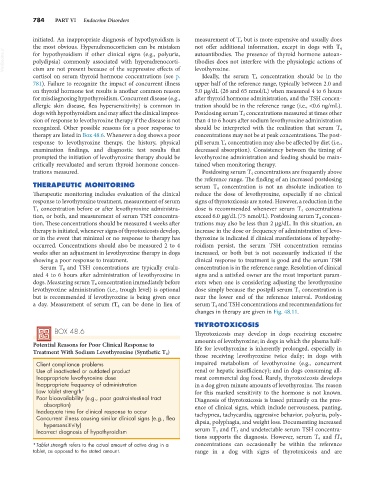Page 812 - Small Animal Internal Medicine, 6th Edition
P. 812
784 PART VI Endocrine Disorders
initiated. An inappropriate diagnosis of hypothyroidism is measurement of T 4 but is more expensive and usually does
the most obvious. Hyperadrenocorticism can be mistaken not offer additional information, except in dogs with T 4
VetBooks.ir for hypothyroidism if other clinical signs (e.g., polyuria, autoantibodies. The presence of thyroid hormone autoan-
tibodies does not interfere with the physiologic actions of
polydipsia) commonly associated with hyperadrenocorti-
cism are not present because of the suppressive effects of
Ideally, the serum T 4 concentration should be in the
cortisol on serum thyroid hormone concentrations (see p. levothyroxine.
781). Failure to recognize the impact of concurrent illness upper half of the reference range, typically between 2.0 and
on thyroid hormone test results is another common reason 5.0 µg/dL (26 and 65 nmol/L) when measured 4 to 6 hours
for misdiagnosing hypothyroidism. Concurrent disease (e.g., after thyroid hormone administration, and the TSH concen-
allergic skin disease, flea hypersensitivity) is common in tration should be in the reference range (i.e., <0.6 ng/mL).
dogs with hypothyroidism and may affect the clinical impres- Postdosing serum T 4 concentrations measured at times other
sion of response to levothyroxine therapy if the disease is not than 4 to 6 hours after sodium levothyroxine administration
recognized. Other possible reasons for a poor response to should be interpreted with the realization that serum T 4
therapy are listed in Box 48.6. Whenever a dog shows a poor concentrations may not be at peak concentrations. The post-
response to levothyroxine therapy, the history, physical pill serum T 4 concentration may also be affected by diet (i.e.,
examination findings, and diagnostic test results that decreased absorption). Consistency between the timing of
prompted the initiation of levothyroxine therapy should be levothyroxine administration and feeding should be main-
critically reevaluated and serum thyroid hormone concen- tained when monitoring therapy.
trations measured. Postdosing serum T 4 concentrations are frequently above
the reference range. The finding of an increased postdosing
THERAPEUTIC MONITORING serum T 4 concentration is not an absolute indication to
Therapeutic monitoring includes evaluation of the clinical reduce the dose of levothyroxine, especially if no clinical
response to levothyroxine treatment, measurement of serum signs of thyrotoxicosis are noted. However, a reduction in the
T 4 concentration before or after levothyroxine administra- dose is recommended whenever serum T 4 concentrations
tion, or both, and measurement of serum TSH concentra- exceed 6.0 µg/dL (75 nmol/L). Postdosing serum T 4 concen-
tion. These concentrations should be measured 4 weeks after trations may also be less than 2 µg/dL. In this situation, an
therapy is initiated, whenever signs of thyrotoxicosis develop, increase in the dose or frequency of administration of levo-
or in the event that minimal or no response to therapy has thyroxine is indicated if clinical manifestations of hypothy-
occurred. Concentrations should also be measured 2 to 4 roidism persist, the serum TSH concentration remains
weeks after an adjustment in levothyroxine therapy in dogs increased, or both but is not necessarily indicated if the
showing a poor response to treatment. clinical response to treatment is good and the serum TSH
Serum T 4 and TSH concentrations are typically evalu- concentration is in the reference range. Resolution of clinical
ated 4 to 6 hours after administration of levothyroxine in signs and a satisfied owner are the most important param-
dogs. Measuring serum T 4 concentration immediately before eters when one is considering adjusting the levothyroxine
levothyroxine administration (i.e., trough level) is optional dose simply because the postpill serum T 4 concentration is
but is recommended if levothyroxine is being given once near the lower end of the reference interval. Postdosing
a day. Measurement of serum fT 4 can be done in lieu of serum T 4 and TSH concentrations and recommendations for
changes in therapy are given in Fig. 48.11.
THYROTOXICOSIS
BOX 48.6 Thyrotoxicosis may develop in dogs receiving excessive
Potential Reasons for Poor Clinical Response to amounts of levothyroxine; in dogs in which the plasma half-
Treatment With Sodium Levothyroxine (Synthetic T 4 ) life for levothyroxine is inherently prolonged, especially in
those receiving levothyroxine twice daily; in dogs with
Client compliance problems impaired metabolism of levothyroxine (e.g., concurrent
Use of inactivated or outdated product renal or hepatic insufficiency); and in dogs consuming all-
Inappropriate levothyroxine dose meat commercial dog food. Rarely, thyrotoxicosis develops
Inappropriate frequency of administration in a dog given minute amounts of levothyroxine. The reason
Low tablet strength* for this marked sensitivity to the hormone is not known.
Poor bioavailability (e.g., poor gastrointestinal tract Diagnosis of thyrotoxicosis is based primarily on the pres-
absorption) ence of clinical signs, which include nervousness, panting,
Inadequate time for clinical response to occur
Concurrent illness causing similar clinical signs (e.g., flea tachypnea, tachycardia, aggressive behavior, polyuria, poly-
hypersensitivity) dipsia, polyphagia, and weight loss. Documenting increased
Incorrect diagnosis of hypothyroidism serum T 4 and fT 4 and undetectable serum TSH concentra-
tions supports the diagnosis. However, serum T 4 and fT 4
*Tablet strength refers to the actual amount of active drug in a concentrations can occasionally be within the reference
tablet, as opposed to the stated amount. range in a dog with signs of thyrotoxicosis and are

